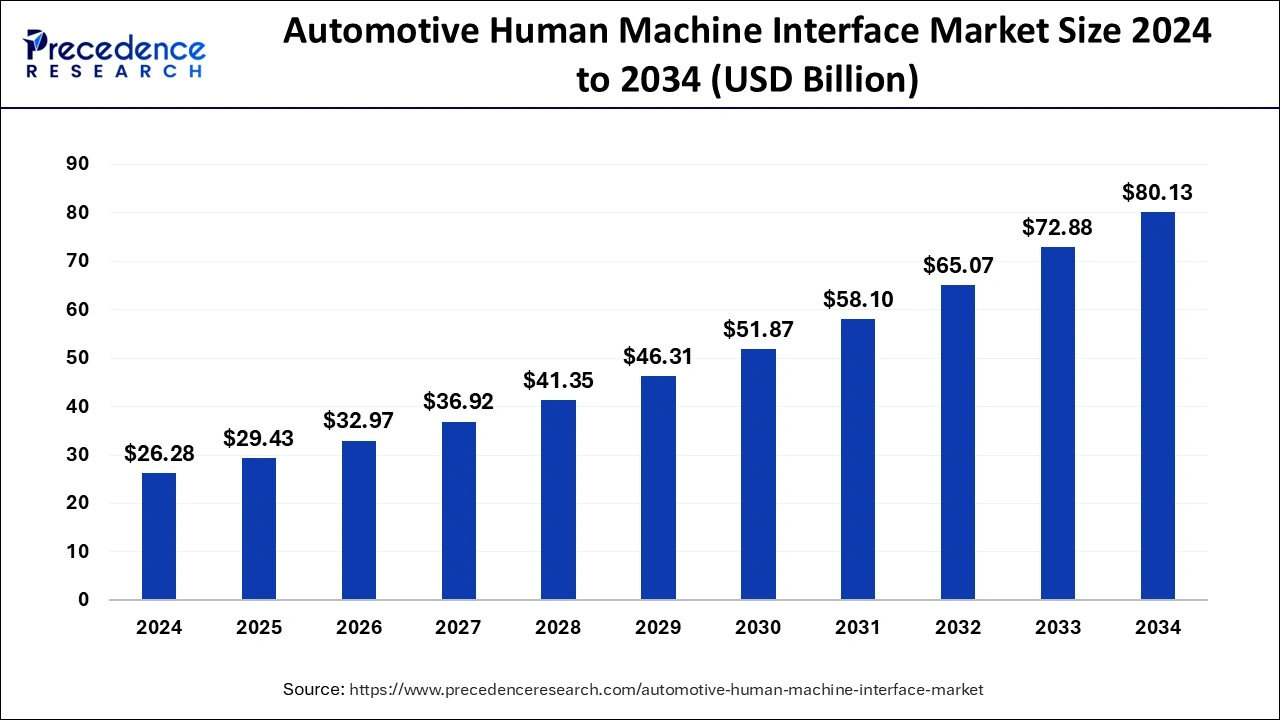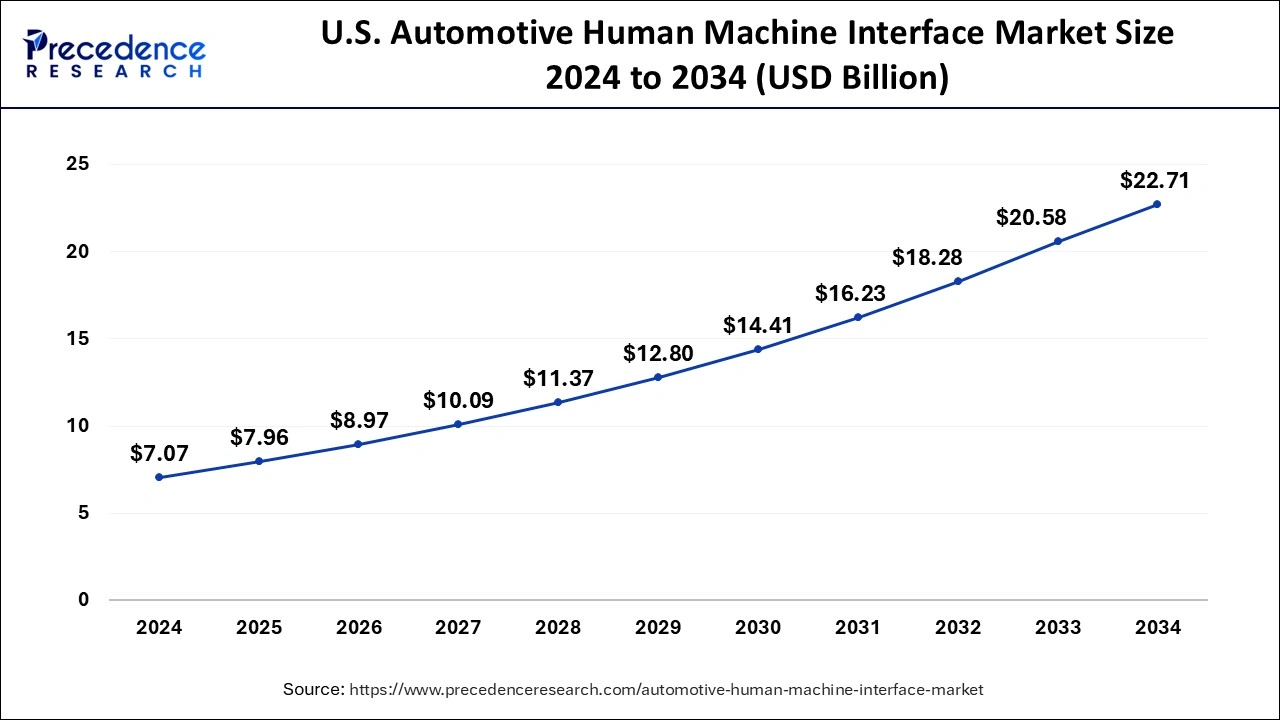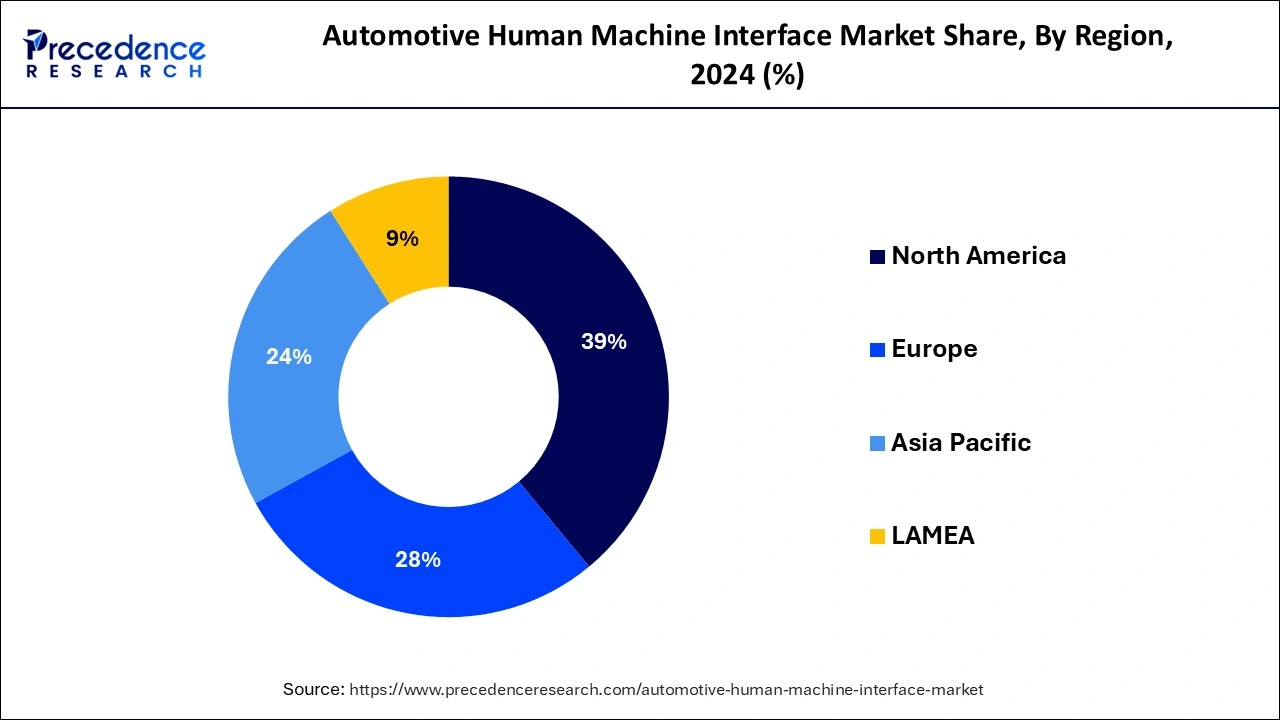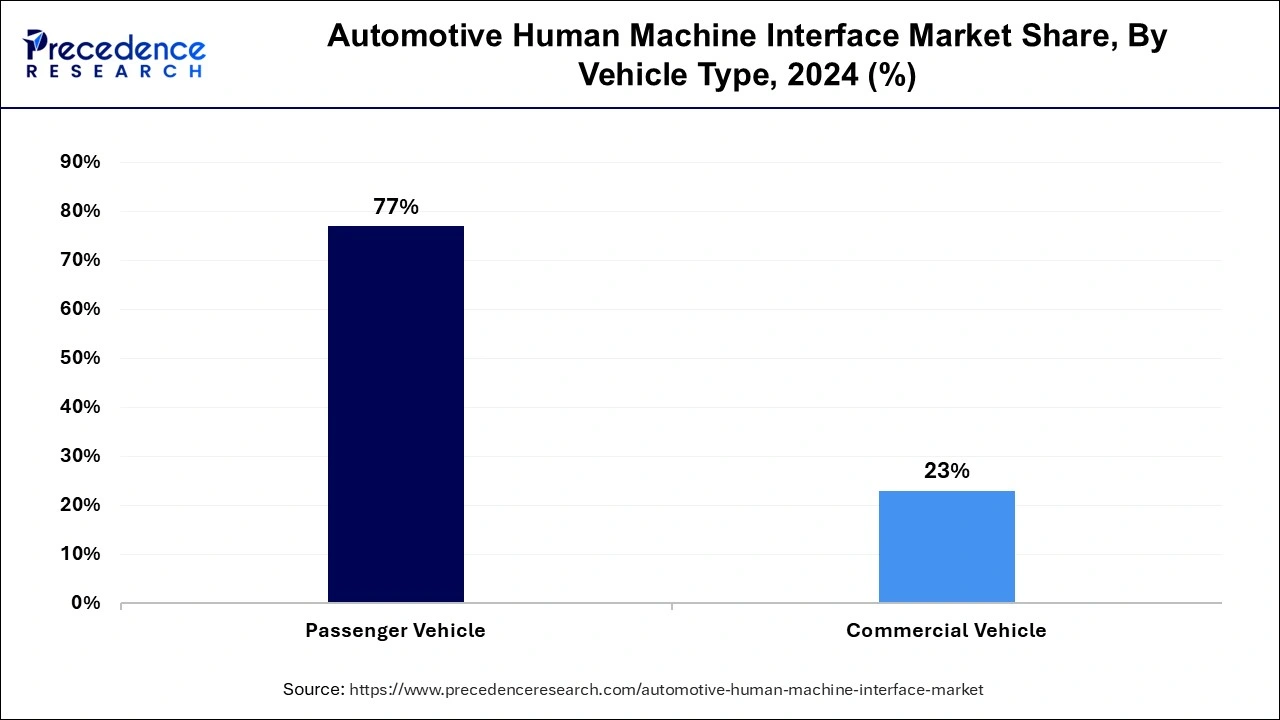January 2025
The global automotive human machine interface market size is calculated at USD 29.43 billion in 2025 and is forecasted to reach around USD 80.13 billion by 2034, a11.79elerating at a CAGR of 11.79% from 2025 to 2034. The North America automotive human machine interface market size surpassed USD 10.25 billion in 2024 and is expanding at a CAGR of 11.80% during the forecast period. The market sizing and forecasts are revenue-based (USD Million/Billion), with 2024 as the base year.
The global automotive human machine interface market size was estimated at USD 26.28 billion in 2024 and is anticipated to reach around USD 80.13 billion by 2034, expanding at a CAGR of 11.79% from 2025 to 2034. The increasing demand for advanced features in luxury vehicles has boosted the growth of the automotive human machine interface (HMI) market.

AI is creating noticeable impact in the automotive industry. Nowadays, automotive HMI developers have started integrating artificial intelligence (AI) in their systems for numerous applications. Firstly, AI helps in enhancing the design of HMI with the use of AI-powered assistants such as Alexa, Siri, Google Assistant, and some others that allow smooth human interactions with devices using natural language. Secondly, AI plays a prominent role in personalization inside the vehicle. AI algorithms helps in analyzing user behavior, preferences, and historical data to personalize interfaces according to individual users. Additionally, AI enhances predictive analytics for forecasting user actions and automating routine tasks in automotives. Thus, the advancements in AI is expected to positively impact the automotive human machine industry.
The U.S. automotive human machine interface market size was evaluated at USD 7.07 billion in 2024 and is predicted to be worth around USD 22.71 billion by 2034, rising at a CAGR of 12.37% from 2025 to 2034.

In North America, the U.S. held a majority share of the market. In U.S., the market is generally driven by the rise in number of automotive manufacturers in places such as Michigan and Detroit. Also, the rising integration of HUD in cars along with numerous collaborations and partnerships among market players also drives the market expansion. Moreover, the technological advancements in automotive industry coupled with increased consumer preference for aesthetics in modern vehicles further proliferates the industrial growth.

In Europe, Germany is a major contributor of this industry. In Germany, this market is growing rapidly due to the presence of well-established automotive industry with companies such as Volkswagen, Porsche, McLaren and some others. Also, the rising adoption of EVs due to increased consumer awareness regarding emission has further contributed to the market growth. Moreover, the increasing sales of luxury vehicles along with rapid investment in automotive aftermarket industry has propelled the market expansion.
A user interface or dashboard that connects a human to a machine, device, or a system is known as automotive human machine interface (HMI). While human machine interface (HMI) can also be referred to any screen that allows a user to interact with a device, it is most usually associated with industrial operations.
The rise in consumer concern about safety and security features, as well as the adoption of superior interiors for automobiles, is the key factors driving the automotive human machine interface (HMI) market growth. Furthermore, the expansion of vehicle production and sales in Asia-Pacific’s developing countries is driving the automotive human machine interface (HMI) market. The progress of communication systems and infotainment systems directly influences the growth of the automotive human machine interface (HMI) market.
The technological advancements that are making the connected vehicles as the future of interaction and communication with other devices in a technology-driven environment are expected to be major factor boosting the demand for automotive human machine interface (HMI) in the market. In addition, the surge in demand for electric vehicles is driving the growth of automotive human machine interface (HMI) market during the forecast period.
Furthermore, the potential to improve the driver’s in-vehicle experience and provide flawless contact between the vehicle and its passengers is projected to complement the growing sales of automotive human machine interface (HMI), ensuring safe and rich on-road experience with diversified communication system.
| Report Coverage | Details |
| Growth Rate from 2025 to 2034 | CAGR of 11.79% |
| Market Size In 2024 | USD 26.28 Billion |
| Market Size In 2025 | USD 29.43 Billion |
| Market Size by 2034 | USD 80.13 Billion |
| Largest Market | North America |
| Base Year | 2024 |
| Forecast Period | 2025 to 2034 |
| Segment Covered | By Technology, By Product Type, and By Vehicle Type |
| Regions Covered | North America, Europe, Asia-Pacific, Latin America, and Middle East & Africa |
The visual segment dominated the market in 2024, in terms of revenue. The visual human machine interface (HMI) system enables data to display visually on the connected devices such as built-in screen on machines, tablets, and computer or laptop monitors. The visual human machine interface (HMI) also provides real time data to the end-users.
On the other hand, the acoustic segment is estimated to be the most opportunistic segment during the forecast period.The key market players are utilizing innovative technologies for the growth of the human machine interface (HMI) market. One of such technology is acoustic technology. This technology helps in the reduction of load of visual and sensory components of the HMI system.
The instrument cluster segment dominated the global automotive human machine interface (HMI) market in 2024, in terms of revenue. The market for automotive instrument cluster is predicted to increase in accordance with the rapid growth of electric vehicle sales. For a better user experience, key market players are utilizing improved graphic displays in automotive instrument cluster.
On the other hand, the heads-up display (HUD) segment is estimated to be the most opportunistic segment during the forecast period. The automotive heads-up display (HUD) segment will rise at a rapid rate during the forecast period, owing to increased efforts to reduce road accidents and increased consumer awareness about vehicle and passenger safety.
The passenger vehicle segment accounted for the largest market share of 77% in 2024. The growing urban population and their commuting needs, have contributed towards the growth of the segment. Furthermore, end-users choose electric automobiles because of low operating and maintenance costs with the growing trend of employing clean energy for vehicle production.

On the other hand, the commercial vehicle segment is estimated to be the most opportunistic segment during the forecast period.The rapid urbanization, rising disposable income, and improved standard of living is influencing the growth of commercial vehicle in the market. Over the last few years, the demand for commercial vehicles has surged. This led to the growing demand for commercial vehicles in most of the developed countries due to regional economic development. As a result, the commercial vehicle is expected to grow and develop at a fast rate.
The automotive human machine interface (HMI) market is moderately fragmented with the presence of several local companies. These market players are striving to gain higher market share by adopting different marketing strategies, such as new product launch, investments, partnerships, and mergers & acquisitions. The companies are also spending on the development of improved products. Moreover, they are also focusing on competitive pricing.
The various developmental strategies such as new product launches, acquisition, partnerships,business expansion, investments, joint venture, and mergers fosters market growth and offers lucrative growth opportunities to the market players.
By Technology
By Product Type
By Vehicle Type
By Geography
For inquiries regarding discounts, bulk purchases, or customization requests, please contact us at sales@precedenceresearch.com
No cookie-cutter, only authentic analysis – take the 1st step to become a Precedence Research client
January 2025
April 2025
January 2024
January 2025